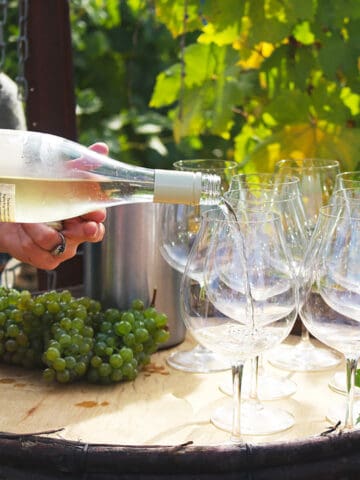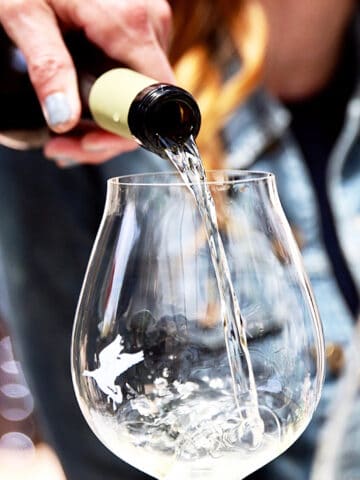These two grape varieties are growing in popularity among wine lovers and novices alike. But they have very distinct flavor and body characteristics that set them apart. Discover the main differences between Riesling vs Gewurztraminer and what makes the wines so unique.

Gewurztraminer (or Gewürztraminer depending on the growing region) is often referred to as an “aromatic wine grape.” What is that? It simply means that it emits noticeable natural scents like citrus or herbs — more so than other types of grapes.
For some, that can be off-putting, but a growing number of wine lovers are rediscovering Gewurztraminer wines, both for their aromas and their inviting sweetness.
Riesling is one of the most wide-ranging wine grapes. Whether you prefer a dry white wine or a sweet version, there’s a Riesling for you. That’s one reason it’s continued to grow in popularity. Once clustered in Europe, this versatile grape is now produced in various regions around the world.
Use this guide to uncover the unique characteristics that set these wines and wine grapes apart. From their palate to ideal food pairings to how much they cost on average, we’ll cover everything you need to know to select your next bottle of either wine (or both!) with confidence.


Jump to:
Origin of Riesling
Riesling is perhaps the most famous of German wines. Dating back more than 500 years, the first Riesling vines are believed to have originated along the Rhine Valley in Germany in the 15th century. Fast forward a few hundred years and by the mid-19th century, Riesling had become one of the most popular wines in Europe, on par with some of the great wines of France.
However, World Wars I and II would severely affect German Riesling production, as many vineyards were destroyed. It would take another 50 years following the end of World War II until the grape would regain its position as the most widely planted in Germany.
While Germany is still recognized as one of the top Riesling regions, the grape is grown in other wine regions, including Austria, Switzerland, France, the United States, Australia, and New Zealand.
Origin of Gewurztraminer
Although a white wine variety, the Gewürztraminer grape has a distinct pink tinge. This gives the resulting wine a slight pinkish hue.
Gewurztraminer vines date back to the 17th century, with the first grapes originating in western Germany. While the wine is still produced in Germany, it is now commonly associated with the nearby Alsace region of France.
In fact, it is among the 4 Grand Cru (or superior quality) grapes of the region, along with Riesling, Muscat, and Pinot Gris. The Alsace climate is sunny but cooler, which helps the grapes ripen fully and balance out acidity levels.
Gewurztraminer wine is usually made in dry to off-dry styles.
Sometimes the grape and the wine is spelled with an umlaut – Gewürztraminer. Traditionally ones produced in France do not include it, so “Gewurztraminer.”
Flavor characteristics and aroma: Riesling

If you like a dry, crisp wine, then you’re in luck with a Riesling. That said, if you like a fuller, sweeter white wine, Riesling also has you covered. That’s because you can find several types that differ based on production methods. More on that below.
In terms of palate, Rieslings often possess citrus and stone fruit flavors like grapefruit, Meyer lemon, pear, and peach, along with hints of minerality.
Some sweeter Rieslings can also have green apple and honeycomb flavors. Along with fruit, you may notice more earthy and flowery flavors like grass and rose blossoms.
While all of those are common across several wine varieties, it’s the aroma where Riesling can take some by surprise, especially if you’ve never tried it. That’s because it often includes hints of gasoline or petrol.
This has to do with a natural compound called TDN, which develops as the grapes are exposed to more daylight. But don’t be put off by this. The more heightened the aroma, the better quality the Riesling tends to be. Which makes sense. After all, the more daylight the grapes are subjected to, the more they can continue to ripen and develop flavor.
Those aren’t the only aromas you’ll notice in Rieslings. Honey, ginger, and jasmine are also common.
6 Classifications of Riesling
When referring to a German Riesling, there are 6 different styles that they can fall into. They indicate the ripeness level of the grapes when they were picked, and by extension, they signify the sweetness of the wine. The wine label will indicate which classification it belongs to. The categories include:
Kabinett (dry)
This light German Riesling is made with grapes that have just ripened. That gives the wines a dryer finish and higher acidity levels. They also feature prominent fruit flavors like pear and apple. These types of wines can be produced as dry or off-dry.
Spätlese (semi-dry to semi-sweet)
Translating to “late harvest,” Spätlese grapes have more time than those used in Kabinett to mature on the vine. This helps them develop richer flavors before they’re picked. The result is a fuller-bodied and more structured wine. Spätlese Riesling can be found in semi-dry wine to semi-sweet styles.
Auslese (semi-sweet to sweet)
Auslese refers to wines produced from a select harvest of grapes. They are traditionally hand-picked and are affected by noble rot, which is a fungus that causes wine grapes to shrivel, concentrating the juice. This in turn adds to the sweetness level.
Though some dry Auslese wines are available, they’re usually semi-sweet to sweet white wines.
Beerenauslese (sweet)
Beerenausleses are generally rich and very sweet wines. For that reason, they’re often viewed as a more traditional dessert wine. They exhibit stone fruit flavors, so not surprisingly, they complement fruity desserts like peach cobbler, as well as richer ones like crème brûlée. This type of wine is also suitable for aging.
Trockenbeerenauslese (sweet)
Trockenbeerenauslese grapes are picked very late in the harvest. They’re left on the vine until they begin to shrivel, and that allows the sugars in the grapes to become very concentrated. The rich sweetness of these wines goes well with similarly sweet desserts like fruit pies, but they also pair nicely with soft, creamy cheeses.
Eiswein (sweet)
If you’re looking for a dessert Riesling, you may want to try one in the Eiswein category. Grapes used in these wines freeze on the vine. As a result, the juice is very concentrated and high in natural sugar. These wines are traditionally low in alcohol and can have a bright acidity.
Flavor characteristics and aroma: Gewurztraminer

Gewurztraminers are bold in both flavor and aroma. Both fruit-forward and highly aromatic white wines, typical Alsatian ones exhibit flavors including peach, tangerine, lychee, pineapple, apricot, grapefruit, ginger, bell pepper, and rose petals. On the nose, you’ll likely notice pronounced tropical fruit and floral aromas.
Apart from fruit, you may also pick up other scents, like smoke or incense, which can give these wines a slight spiciness.
In terms of finish, these fuller-bodied wines can be very distinct, sometimes having an almost oily texture. And depending on the growing region they may have a certain bitterness as well.
Acidity
While Rieslings tend to have high levels of acidity, Gewurztraminers often fall at the other end of the spectrum. They tend to have low acidity, higher alcohol content, and a fuller body than most white wines.
Riesling
As we’ve seen, several styles of Rieslings are produced to be sweet or semi-sweet. That’s because the grapes are naturally very high in acidity (as they’re traditionally grown in a cooler climate). To balance them out, some sweetness is added to certain Rieslings during the fermentation process.
But this isn’t done by adding sugar. Rather, winemakers stop the fermentation process before all of the grape sugars have been converted to alcohol. The extra natural sugars help make Rieslings crisper and rounder, rather than overly tart. And since the fermentation process is arrested, these sweeter wines tend to have less alcohol.
Gewurztraminer
Gewurztraminer grapes are also grown in cool climates, and like many sweet Rieslings, the grapes are allowed to ripen on the vine for long periods. This allows more natural sugars to develop. Its naturally high acidity levels balance them out, creating pleasantly off-dry or semi-sweet gewürztraminer wine.
Body
Most Rieslings are light-bodied, with a crisp and clean finish. This is true regardless of the growing region. Since many Rieslings are made sweet by halting the fermentation process and arresting the conversion of sugar to alcohol, they often have lower alcohol content. Many average around 10%-12% ABV.
On the other hand, Gewurztraminers are often fuller-bodied white wines, due in part to their lower acid levels. So you’ll notice a softer, rounder mouthfeel. These wines also have a relatively high alcohol content for a white wine, falling in the 13%-15% ABV range. This helps give the wine more structure and heft.
Color

The color of Rieslings can vary depending on style. Dry Rieslings often have a light yellow or pale straw hue. Sweeter ones exhibit richer colors with darker golden hues.
As noted above, Gewurztraminer grapes are pink rather than the light green that’s typical in ones used to make white wines. And while the resulting wine is usually a pale yellow, you may notice a slight pink tinge.
Food pairings
Riesling
Rieslings come in a range of styles from dry to sweet, and the foods they pair well with vary widely as well.
Try semi-dry or dry versions with seafood like sushi and shellfish, as well as softer cheeses. Semi-sweet Rieslings pair well with spicy dishes like curries, Thai food, and Mexican food. And sweeter dessert wines complement sweet and creamy dishes like fruit pies, custards, and crème brûlée.
Gewurztraminer
Gewürtztraminer wine pairs well with spicy food like Indian or Thai curries, as well as Moroccan tagines. It also goes well with heavier fish like salmon or swordfish, poultry like duck and chicken, and roasted vegetables including squash and eggplant.

Pair Gewürztraminer with lightly flavored rather than overpowering cheeses. And for dessert, a good Gewurztraminer food pairing includes spiced dishes like pumpkin pie, strudel, and apple crumble.
Price
If you’re ready to try a bottle of Gewurztraminer or Riesling, you can find a good example of either without breaking the bank.
Quality Rieslings generally go for around $15-$25 at local wine shops and grocery stores. And you can likely find them for less online if you do some shopping around.
Gewurztraminers are generally more affordable. You can find several in the $10-$20 range. And these will make for perfect wines to try if you’re new to this wine style.
While some very high-quality Riesling and Gewurztraminer can be cellared and aged, most are meant to be consumed sooner rather than later and will likely not improve with age.
Gewurtztraminer vs Riesling summary
Gewurztraminer
- Primary growing regions: Alsace (France), Germany
- Worldwide growing acres: 20,000
- Dry to Semi-Sweet
- Body: medium bodied
- Color: Pale yellow with pinkish tinge
- Acidity: Low to medium
- Flavor notes: Lychee, peach, tangerine pineapple, apricot, grapefruit, ginger, rose, smokiness
- Cost: $10-$20+
Riesling
- Primary growing regions: Germany, Austria, France, United States, New Zealand, Australia
- Worldwide growing acres: 89,000
- Dry to Very Sweet
- Body: Light to medium-light
- Color: Pale yellow to medium gold
- Acidity: Generally high
- Flavor notes: Lemon, grapefruit, pear, peach, green apple, honey, grass, rose blossoms
- Cost: $15-$20+
More wine answers
Discover more about your favorite wines, or get new to know some new ones. Check out the posts below.






Leave a Reply